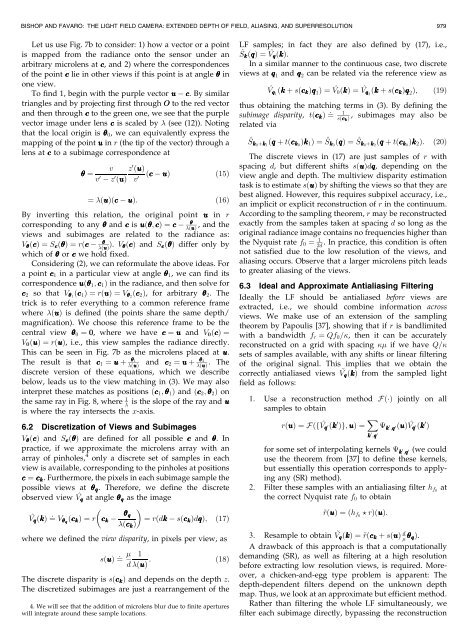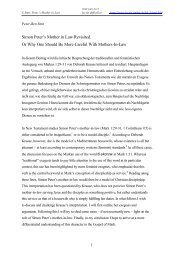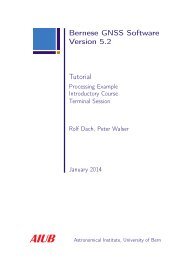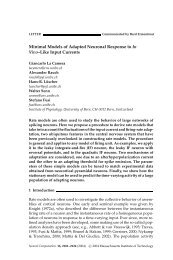The Light Field Camera: Extended Depth of Field, Aliasing, and ...
The Light Field Camera: Extended Depth of Field, Aliasing, and ...
The Light Field Camera: Extended Depth of Field, Aliasing, and ...
- No tags were found...
Create successful ePaper yourself
Turn your PDF publications into a flip-book with our unique Google optimized e-Paper software.
BISHOP AND FAVARO: THE LIGHT FIELD CAMERA: EXTENDED DEPTH OF FIELD, ALIASING, AND SUPERRESOLUTION 979Let us use Fig. 7b to consider: 1) how a vector or a pointis mapped from the radiance onto the sensor under anarbitrary microlens at c, <strong>and</strong> 2) where the correspondences<strong>of</strong> the point c lie in other views if this point is at angle inone view.To find 1, begin with the purple vector u c. By similartriangles <strong>and</strong> by projecting first through O to the red vector<strong>and</strong> then through c to the green one, we see that the purplevector image under lens c is scaled by (see (12)). Notingthat the local origin is 0 , we can equivalently express themapping <strong>of</strong> the point u in r (the tip <strong>of</strong> the vector) through alens at c to a subimage correspondence at ¼v 0v z 0 ðuÞz 0 ðuÞ v 0 ðc uÞ ð15Þ¼ ðuÞðc uÞ: ð16ÞBy inverting this relation, the original point u in rcorresponding to any <strong>and</strong> c is uð; cÞ ¼cðuÞ, <strong>and</strong> theviews <strong>and</strong> subimages are related to the radiance as:V ðcÞ ¼S c ðÞ ¼rðcðuÞ Þ. V ðcÞ <strong>and</strong> S c ðÞ differ only bywhich <strong>of</strong> or c we hold fixed.Considering (2), we can reformulate the above ideas. Fora point c 1 in a particular view at angle 1 , we can find itscorrespondence uð 1 ;c 1 Þ in the radiance, <strong>and</strong> then solve forc 2 so that V 1 ðc 1 Þ¼rðuÞ ¼V 2 ðc 2 Þ, for arbitrary 2 . <strong>The</strong>trick is to refer everything to a common reference framewhere ðuÞ is defined (the points share the same depth/magnification). We choose this reference frame to be thecentral view 0 ¼ 0, where we have c ¼ u <strong>and</strong> V 0 ðcÞ ¼V 0 ðuÞ ¼rðuÞ, i.e., this view samples the radiance directly.This can be seen in Fig. 7b as the microlens placed at u.<strong>The</strong> result is that c 1 ¼ u þ 1ðuÞ<strong>and</strong> c 2 ¼ u þ 2ðuÞ . <strong>The</strong>discrete version <strong>of</strong> these equations, which we describebelow, leads us to the view matching in (3). We may alsointerpret these matches as positions ðc 1 ; 1 Þ <strong>and</strong> ðc 2 ; 2 Þ onthe same ray in Fig. 8, where 1 is the slope <strong>of</strong> the ray <strong>and</strong> uis where the ray intersects the x-axis.6.2 Discretization <strong>of</strong> Views <strong>and</strong> SubimagesV ðcÞ <strong>and</strong> S c ðÞ are defined for all possible c <strong>and</strong> . Inpractice, if we approximate the microlens array with anarray <strong>of</strong> pinholes, 4 only a discrete set <strong>of</strong> samples in eachview is available, corresponding to the pinholes at positionsc ¼ c k . Furthermore, the pixels in each subimage sample thepossible views at q . <strong>The</strong>refore, we define the discreteobserved view ^V q at angle q as the image^V q ðkÞ ¼ : V ðc q kÞ¼r c k qðc k Þ¼ rdk ð sðc k ÞdqÞ; ð17Þwhere we defined the view disparity, in pixels per view, assðuÞ ¼ : 1d ðuÞ :ð18Þ<strong>The</strong> discrete disparity is sðc k Þ <strong>and</strong> depends on the depth z.<strong>The</strong> discretized subimages are just a rearrangement <strong>of</strong> the4. We will see that the addition <strong>of</strong> microlens blur due to finite apertureswill integrate around these sample locations.LF samples; in fact they are also defined by (17), i.e.,^S k ðqÞ ¼ ^V q ðkÞ.In a similar manner to the continuous case, two discreteviews at q 1 <strong>and</strong> q 2 can be related via the reference view as^V q1 ðk þ sðc k Þq 1 Þ¼ ^V 0 ðkÞ ¼ ^V q2 ðk þ sðc k Þq 2 Þ;ð19Þthus obtaining the matching terms in (3). By defining thesubimage disparity, tðc k Þ¼ : 1sðc kÞ, subimages may also berelated via^S k0 þk 1ðq þ tðc k0 Þk 1 Þ¼ ^S k0 ðqÞ ¼ ^S k0 þk 2ðq þ tðc k0 Þk 2 Þ:ð20Þ<strong>The</strong> discrete views in (17) are just samples <strong>of</strong> r withspacing d, but different shifts sðuÞdq, depending on theview angle <strong>and</strong> depth. <strong>The</strong> multiview disparity estimationtask is to estimate sðuÞ by shifting the views so that they arebest aligned. However, this requires subpixel accuracy, i.e.,an implicit or explicit reconstruction <strong>of</strong> r in the continuum.According to the sampling theorem, r may be reconstructedexactly from the samples taken at spacing d so long as theoriginal radiance image contains no frequencies higher thanthe Nyquist rate f 0 ¼ 12d. In practice, this condition is <strong>of</strong>tennot satisfied due to the low resolution <strong>of</strong> the views, <strong>and</strong>aliasing occurs. Observe that a larger microlens pitch leadsto greater aliasing <strong>of</strong> the views.6.3 Ideal <strong>and</strong> Approximate Antialiasing FilteringIdeally the LF should be antialiased before views areextracted, i.e., we should combine information acrossviews. We make use <strong>of</strong> an extension <strong>of</strong> the samplingtheorem by Papoulis [37], showing that if r is b<strong>and</strong>limitedwith a b<strong>and</strong>width f r ¼ Qf 0 =, then it can be accuratelyreconstructed on a grid with spacing if we have Q=sets <strong>of</strong> samples available, with any shifts or linear filtering<strong>of</strong> the original signal. This implies that we obtain thecorrectly antialiased views ~V q ðkÞ from the sampled lightfield as follows:1. Use a reconstruction method FðÞ jointly on allsamples to obtainrðuÞ ¼Fðf^V q 0ðk0 Þg;uÞ ¼ X k 0 ;q 0k 0 ;q 0ðuÞ ^V q 0ðk0 Þfor some set <strong>of</strong> interpolating kernels k 0 ;q (we could0use the theorem from [37] to define these kernels,but essentially this operation corresponds to applyingany (SR) method).2. Filter these samples with an antialiasing filter h f0 atthe correct Nyquist rate f 0 to obtain~rðuÞ ¼ðh f0 ?rÞðuÞ:3. Resample to obtain ~V q ðkÞ ¼~rðc k þ sðuÞ d qÞ.A drawback <strong>of</strong> this approach is that a computationallydem<strong>and</strong>ing (SR), as well as filtering at a high resolutionbefore extracting low resolution views, is required. Moreover,a chicken-<strong>and</strong>-egg type problem is apparent: <strong>The</strong>depth-dependent filters depend on the unknown depthmap. Thus, we look at an approximate but efficient method.Rather than filtering the whole LF simultaneously, wefilter each subimage directly, bypassing the reconstruction
















